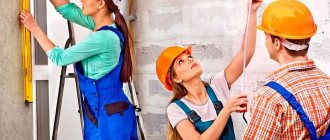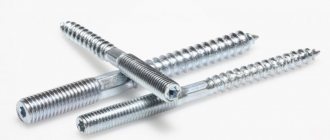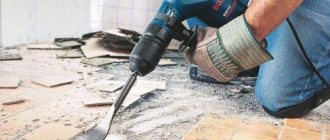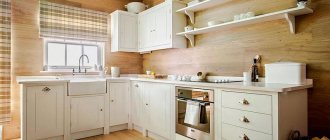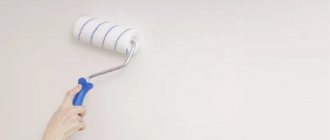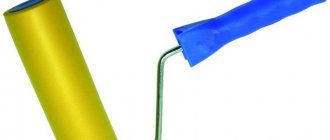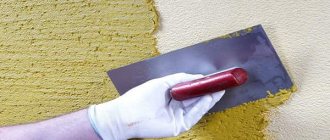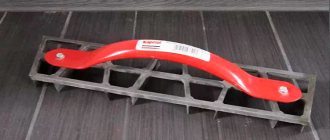Characteristics and advantages of the material
- Functionality. DSP panels are the main element in the construction of frame-panel structures; they are necessary for cladding the frame base outside the walls. In addition, they are used to line the internal partitions of buildings. They are necessary for leveling the floor covering without the use of self-leveling technologies or other traditional methods of installing floors. They are also used for installing window sills in buildings in different areas - residential or office. Window sills made of this material are not inferior to their wooden counterparts, and in terms of strength they are better than plastic models. Thanks to them, they produce communication boxes, canopies for porches, and install paths for buildings.
- Cement particle board is a truly durable material, which is determined by the production technology: elevated temperatures contribute to the production of a monolith that can withstand enormous loads. If you bend the material, the deformation will be no more than 10%.
- Machinability. Such panels can be easily sawed, cut, sanded, milled and other operations. The work uses tools like a steel drill, grinder or circular saw.
- Moisture resistant. The mineral elements contained in the material and the smooth coating make the product resistant to moisture. But minor swelling indicators are still present: immersing it in liquid for a day, the product will swell only by a couple of percent. It is for these purposes that there are minimal gaps between the plates. An even coating allows water to quickly evaporate, so the sheets are often used to create moisture-resistant walls and to equip sanitary rooms in public buildings.
- Environmentally friendly. DSP is an absolutely environmentally friendly material that does not contain formaldehydes, phenols, carcinogenic mixtures and toxic substances are excluded. Slab panels do not accumulate electrical charges.
- Fire resistance. Cement particle board is a material that is difficult to ignite and burns poorly. Even if there is a fire, the fire will go slowly and will be located only in the area of the fire itself. When smoke appears, the release of toxic substances is excluded.
- Resistant to low temperatures. DSP has better frost resistance. This is an important indicator for construction in Siberia or the Far North.
Where to buy DSP
Trading House "ALEX-STROY" offers to buy high-quality chipboards at manufacturer's prices. In addition to these slabs, you can order wall panels, decking, bagged cement, asbestos-cement pipes, corrugated slate, chipboard, reinforced concrete products and much more on the website. The product is available not only to residents of Moscow Region, but throughout Russia. Additional information is available in the online store www.alexstroi.ru
Related links: Why many people choose beige shades for their interior
DSP is somewhat more expensive than other materials for “dry installation”, but taking into account the durability and reduced construction time, the cost of the former is cheaper. These slabs are used to construct flat roofs, build fences, erect internal partitions, cladding facades, and make subfloors and ceilings. The material is used for construction from scratch and for repairing existing facilities.
Sawing CBPB
Cement particle board, or in other words CSP, is a building material that is now often found in construction work. Due to the fact that the element is made of aluminum, it is characterized by high strength and wear resistance. Such slabs are an ideal combination of the best characteristics of wood and cement. What to cut CBPB with? For sawing, the main thing is to use a cutting device with high strength; it is recommended to give preference to hard alloys. Dust will appear during the process, so you need to protect your respiratory tract.
How to cut a DSP board without chipping at home? This material can be easily cut, sanded, drilled, and also milled to suit the needs of installation at a specific site. To cut a slab, all you need is a hand or electric saw with a tungsten and carbide blade. For proper drilling, you will need high-speed screw drills. The optimal method is in a factory setting where special equipment is available.
What else do you need to know?
When you plan to saw off everything without chipping on one side, it is permissible to use files with both upper and lower teeth. Most craftsmen prefer small files with straight teeth. Such devices chip less material, but still work quite well. After cutting, it is best to process the ends with emery stretched over even bars. If you don’t have a ready-made crayon of a suitable color, you can mix different crayons, like paints in an artist’s palette, and get a new color.
READ Replacing Batteries in a Makita Screwdriver
To cut without errors and quickly, you must always take into account the brand markings. There is no generally binding designation standard yet, but almost all companies strictly follow the classification developed by Bosch specialists. Or at least they list it along with their own abbreviations and terms. CV saws (sometimes referred to as HCS) are well suited for cutting wood and wood-based products.
Hardwood files are intended for processing laminated panels (they are also useful, note, when processing hard wood).
Some inscriptions indicate in which mode the tool works optimally:
basic - a simple blade that allows you to make a clean cut of high quality;
speed - a device whose teeth are set apart (this allows you to cut faster);
clean - a blade that has not been cut (usually gives the cleanest cut).
If the workpiece is relatively thick, it is preferable to have a saw blade with large cutters that are not set apart, then the deviation from the vertical will be minimal. A longitudinal (relative to the fibers) incision is most often made with helical saws. For a transverse one, a straight blade is better suited. When you plan to make a piece of furniture, it is advisable to choose a less productive, but more accurate tool. Since most saws produced today cut the material as it is pulled in, the workpiece will need to be processed from the inside out.
Sawing methods
What to cut CBPB with? Suitable methods for sawing cement particle boards involve the use of:
- Crosscut or portable circular saws.
- Hacksaw (machine) or machine (format).
How to cut a DSP board without chipping? It is important to immediately treat the edges during installation and apply protective agents. Installation of cement bonded particle boards often involves many holes for fixing. It is better to do these actions using a drill with a torque of about 220 revolutions in 60 seconds. In addition, you will need drills for working with steel or a portable drill press that has tungsten drills.
Recommendations
How to saw a DSP board? If there is no desire to make holes in the cement bonded particle board, then the coatings should be fixed exclusively with self-tapping screws. In terms of strength, they are better than wood chip coatings, but they can be worked with similar devices. What to cut CBPB with? For professional processing, you should use devices that cut hard alloy coatings. Slabs can be cut to size at the customer’s request at the factory. If you need to cut the coating at the installation site, it is recommended to use a cutting tool with plates made of hard alloy.
Important! You need to think in advance about suctioning dust and sawdust from the milling area. Cement particle boards have an even and smooth coating, so grinding is not done at the factory. In addition, this treatment of the entire surface of the slab will knock off the top coating, and the structure of the product will be exposed. This contributes to an increase in water absorption, and subsequently a decrease in physical and mechanical characteristics.
Fastening cement bonded particle boards to a wooden frame
need to be prepared before attaching the slats to the façade. They beat off weak points and open up cracks. If the dowel gets into an unreinforced layer, the sheathing will wobble. Install the insulation on the wall, the material is fixed with dowels with wide caps (mushrooms).
Further actions:
- over the entire wall area attach the frame sheathingFor this purpose, galvanized profiles or wooden blocks treated with drying oil are used;
- during the installation process , verticality and horizontality are adjusted , a flat surface is formed in order to attach the DSP to the wooden frame without distortions;
- install windproof membrane so that there is a gap of at least 1 - 1.5 cm between it and the insulation;
- You cannot drill into the DSP directly with a self-tapping screw; you must first make holes in the panel with a diameter 0.5 mm smaller than the diameter of the hardware.
Valera
The voice of the construction guru
Ask a Question
The holes are made no closer than 10 mm from the edge with a pitch of 45 - 50 cm. The DSP sheets are fastened so that there is a gap of about 5 mm between them, which will subsequently be sealed with sealant. Countersink holes are made under the heads so that they are hidden in the body of the slab.
Fasteners for CBPB
More often, panels are fixed to frame elements using nails and self-tapping screws . Anchor bolts are used to fix the racks and cross members of the frame sheathing to the wall of the building.
The bolts can be metal or plastic, and the screws in them can be twisted or driven in. The length is chosen so that the hardware extends 40 - 50 mm into the concrete or brick. To fasten other parts, various hardware :
- Brackets and hangers from the drywall fastening system. With their help, wooden slats are leveled in a plane and verticality is coordinated.
- Self-tapping screw "flea" . Used when installing a frame made of galvanized profiles to connect metal profiles with hangers. In the case of wooden sheathing, wood screws are used.
- Dowel mushroom . These types of fasteners with large heads secure roll insulation, for example, mineral wool.
Valera
The voice of the construction guru
Ask a Question
Nails are used with a helical surface of the rod. If the slab moves after being secured, the nail may bend but will not cut it off. This is especially important for roof slopes if they are on a slight slope. The length of the hardware is taken so that it is 2.5 times the thickness of the DSP.
Tips from experts for dust-free sawing
How to cut a DSP board without dust? You can prevent or reduce the amount of dust from cutting products using the following means and methods:
- The plate must be pre-wetted. Wipe with a damp cloth, cut slightly and wipe again.
- An electric saw with a blade will produce much less dust than a standard grinder.
- You can take a jigsaw, find an old vacuum cleaner that will have a container for collecting dust. The bag must be disposable. The vacuum cleaner needs to be turned on and directed to the area where you are working. It is advisable to find an assistant. By spraying the parts with a sprayer in advance, you can reduce the occurrence of dust to a minimum.
Features of sawing tiles with a jigsaw
The work area should be stable with as level a surface as possible, and most of the tiles should be pressed tightly against it. The smallest segment should be located on the weight, even if it is precisely this that is necessary for installation. To reduce vibrations, it is better to fix the tiles with a couple of clamps with rubberized clamps. To avoid scratches, you can glue a piece of cardboard or plastic to the metal sole of the jigsaw using double-sided tape.
Cutting DSP using a grinder
When the special saw blade is prepared and the tile is sufficiently moistened, you can safely begin processing it. Cutting tiles with a jigsaw has certain features and is somewhat different from the wood, metal, plastic and other elastic materials we are used to. First of all, you should not rush and try to speed up the slow cutting process by pressing on the jigsaw or increasing its speed, which should range from minimum to medium values. This approach will lead to the formation of serious chips, and strong pressing of a working tool can even crack the tile. It’s not pleasant to waste valuable material, time and saw blade resources.
To reduce the likelihood of defects, it is recommended to cut the tiles at minimum speed, while producing medium pressure sufficient to keep the working jigsaw on the mowing line and direct it forward.
Necessary equipment and materials
What to cut CBPB with? First of all, due to the large weight, the sound will not provoke resonance of a slab weighing 50-70 kg. Products are easy to break. Cutting long models will be tedious. The slabs should be cut with a grinder that has a cutting wheel for concrete or stone. Cement particle board is in fact a layer of concrete, only thin and with a slight addition of wood. Often, insulation is used as a coating on the outside of a suspended ventilated façade.
Installation technology
A significant disadvantage of the material is its significant weight, so before starting work, the condition of the foundation is assessed. If necessary, it is further strengthened. It is recommended to highlight the basement area against the general background of the façade cladding.
Lathing installation and insulation
To create the frame, timber or profiles are used, the method is selected based on the specific situation. The first type is more suitable for log houses, the second - for brick, concrete or similar surfaces.
To equip ventilated facades, wooden beams or metal profiles are used; perforated hangers and a windproof membrane are also required
Wooden structure
The process begins with the preparation of the racks: they are treated with special protective compounds that prevent rotting and fire.
The parts must be secured in the following order:
- The frame elements are dried and the surface is marked. To do this, the optimal step for placing parts is determined, the standard value is 50–60 cm. This distance allows you to lay thermal insulation.
Wooden houses are insulated with mineral wool, and block and frame structures are insulated with foam plastic or extruded polystyrene foam - The posts are drilled out at intervals of 35–45 cm. The greater the weight of the slab, the smaller the indentation. This technology is appropriate when using self-tapping screws, this will avoid cracking.
- If the base is not wooden, then the holes are transferred to the installation lines. Places for dowels are formed.
When using mineral wool, it is advisable to cover the insulation with a steam and windproof membrane on both sides; polystyrene boards do not require such arrangement - A thrust board will provide additional rigidity: it is leveled and mounted on top of the base. If required, a vapor barrier is pre-laid.
- The racks must be mounted exactly level, starting from the corners. Next, a cord is stretched between the elements, along which the remaining parts are placed. If a gap occurs, spacers are used.
The 2 outer posts are attached first, after which several cords are stretched between them, focusing on which the remaining bars of the sheathing are installed - Mineral wool is placed in the cells, and the structure is lined with wind protection around the perimeter. On top of the parts there are slats for an air gap.
- The resulting pie will provide the necessary comfort in the home.
A wooden counter-batten, 30 - 40 mm thick, is placed directly on the supporting posts on top of the wind protection, and the DSP will be attached to it
Metal sheathing
Installation of such a frame occurs a little differently:
- The base is being prepared and markings are being made.
- Hanging brackets are placed along the existing lines and fixed in increments of 35–45 cm with self-tapping screws and dowels.
- Rows of insulation are laid. It can be penoplex or stone wool. The material is pinned onto structural elements and additionally attached to the walls.
Polystyrene foam and extruded polystyrene foam do not require a windproof membrane, since they are not afraid of moisture and, in fact, are waterproofers - Wind protection is laid.
- The outer posts are attached first, and a plane is formed along them.
The technique for installing racks in a single plane for metal and wood sheathing is similar
The convenience of the method lies in the fact that there is no need to erect a counter-lattice, since the thermal insulation is not lined flush with the external elements.
Fastening panels
To sheath a house, the slabs are initially cut to the required size. For these purposes, a grinder with a concrete attachment is used. Drilling is carried out according to the location of the frame parts.
All slabs in which cement is the binder can be cut perfectly with a grinder with a diamond blade.
Scheme of work:
- The façade material is carried along the edges with a slight slope. This will allow you to immediately install the element in place.
- A lath is laid along the upper section of the plinth. It must have the thickness of the required gap.
Cladding slabs are installed with a shift between rows, according to the principle of brickwork - The fragment is placed in place according to the level and baited. It is necessary to check the accuracy of the location, and then finally fix it.
- The following parts are mounted in compliance with the size of the joint.
Particular attention is paid to the window opening: additional frame elements are installed below, above and along the perimeter.
When cladding a façade, a damping gap of about 6–8 mm must be left between the slabs.
Sealing seams
The undeniable advantage of DSP is its low level of moisture absorption, but every open seam is a threat of its penetration inside.
The easiest way to seal joints is to apply sealant evenly. The composition is packaged in tubes, so you will need a construction gun. This option is especially relevant if the area will be covered with molding. The fact is that even the most elastic material will become covered with cracks over time at the points of contact with the slab.
Before plastering, it is advisable to put a sealant in the seams, and then fix the gap with sealant
Laying polymer putty is a more stable method; if repairs are necessary, finishing the damaged area will be much easier. The seam is treated with a primer and sealed; reinforcing tape can be laid on top if the base is to be plastered.
A suitable solution is selected based on the design features.
Fixation points are also sealed, especially if the surface is to be painted.
Finishing
Although DSP boards for facades can play an independent decorative role, it is better to use them as a final coating. The resulting surface can be covered with different materials; the easiest way is to apply paint. Any composition is suitable for this.
The technology is as follows:
- The base is cleared of all excess, the places where the putty is placed are sanded.
- Priming is being carried out. You can use concrete contact. Although many people claim good adhesion of such walls, problems can arise, so it is better to apply two layers, waiting for each to dry.
- Painting is carried out with a roller or spray; brushes are used for difficult areas. The mixture is spread evenly until the desired result is obtained.
An excellent decorative effect can be achieved if the main external areas are made in one shade, and the moldings for the joints are contrasting. They can be painted or purchased ready-made.
For the home craftsman, the easiest way to decorate DSP facades is to paint and install contrasting moldings
Algorithm of actions and tips
If necessary, it is recommended to cut the cement particle board with a circular saw or a machine; saw blades are suitable as an analogue. The plates must be made of hard alloy. DSP boards are manufactured in such a way that they have a smooth gray coating, suitable for priming and further painting without puttying. The strength of the product does not depend on the area of application and deformation, namely, it does not depend on whether the tile is fixed in a transverse or longitudinal format. The product is monolithic, will not delaminate, it is only unstable to the atmospheric factor.
When constructing any building, safety and environmental friendliness will be a priority. The thicker the slab, the more difficult and dangerous it will be to work with it manually. The slabs have a smooth coating and their thickness is about 8-36 mm.
Cement particle board is a new and modern material that is often found in construction activities. It combines the best properties of wood and cement. Such products can be not only a surface, but also suitable as a material for the walls of a frame building. They have excellent durability.
Scope of application
What you can do with the help of DSP:
- decorate residential buildings, shops, administrative and industrial premises inside and outside;
- build warehouses, hangars, garages, change houses, temporary buildings, extensions to the main buildings;
- perform reusable and permanent formwork;
- used as frames for monolithic frame construction;
- erect fences and sound-absorbing structures next to noisy highways;
- produce outdoor advertising and signs;
- line elevator shafts;
- make technological niches and partitions.
Related links: Choosing an electric kettle

